Effects of the Washing Time and Washing Solution on the Biocompatibility and Mechanical Properties of 3D Printed Dental Resin Materials
Abstract
:1. Introduction
2. Materials and Methods
2.1. 3D Specimen CAD Design and Printing
2.2. Washing the 3D Printed Specimens and the Post-Curing Process
2.3. Biocompatibility Test
2.3.1. In Vitro Cell Culture and Cell Line
2.3.2. Cell Viability and Cytotoxicity Assays
2.3.3. Confocal Laser Scanning Microscopy Analysis
2.4. Flexural Strength and Flexural Modulus Test
2.5. Scanning Electron Microscopy Analysis
2.6. Statistical Analysis
3. Results
3.1. Biocompatibility Test
3.1.1. Cell Viability Assay
3.1.2. Cytotoxicity Assay
3.1.3. CLSM Analysis
3.2. Flexural Strength
3.3. Flexural Modulus
3.4. SEM Analysis
4. Discussion
5. Conclusions
- (1)
- As the washing time increased, the cell viability increased and the cytotoxicity decreased, indicating an improved biocompatibility;
- (2)
- As the washing time increased, there were no reductions in the flexural strength or changes in surface defects, while the flexural modulus decreased;
- (3)
- Neither washing solution (IPA or TPM) caused significant defects in mechanical properties, and the biocompatibility increased with the washing time for both solutions.
Author Contributions
Funding
Institutional Review Board Statement
Informed Consent Statement
Data Availability Statement
Conflicts of Interest
References
- Bayne, S.; Heymann, H. CAD/CAM in dentistry: Present and future applications. Quintessence Int. 1996, 27, 431–433. [Google Scholar]
- Beuer, F.; Schweiger, J.; Edelhoff, D. Digital dentistry: An overview of recent developments for CAD/CAM generated restorations. Br. Dent. J. 2008, 204, 505–511. [Google Scholar] [CrossRef] [PubMed]
- Abduo, J.; Lyons, K.; Bennamoun, M. Trends in computer-aided manufacturing in prosthodontics: A review of the available streams. Int. J. Dent. 2014, 2014, 783948. [Google Scholar] [CrossRef] [Green Version]
- Atzeni, E.; Salmi, A. Economics of additive manufacturing for end-usable metal parts. Int. J. Adv. Manuf. Technol. 2012, 62, 1147–1155. [Google Scholar] [CrossRef]
- Van Noort, R. The future of dental devices is digital. Dent. Mater. 2012, 28, 3–12. [Google Scholar] [CrossRef]
- Stansbury, J.W.; Idacavage, M.J. 3D printing with polymers: Challenges among expanding options and opportunities. Dent. Mater. 2016, 32, 54–64. [Google Scholar] [CrossRef]
- Dawood, A.; Marti, B.M.; Sauret-Jackson, V.; Darwood, A. 3D printing in dentistry. Br. Dent. J. 2015, 219, 521–529. [Google Scholar] [CrossRef] [PubMed]
- Bhargav, A.; Sanjairaj, V.; Rosa, V.; Feng, L.W.; Yh, J.F. Applications of additive manufacturing in dentistry: A review. J. Biomed. Mater. Res. Part B Appl. Biomater. 2018, 106, 2058–2064. [Google Scholar] [CrossRef]
- Dodziuk, H. Applications of 3D printing in healthcare. Kardiochirurgia i Torakochirurgia Polska 2016, 13, 283. [Google Scholar] [CrossRef]
- Methani, M.M.; Revilla-León, M.; Zandinejad, A. The potential of additive manufacturing technologies and their processing parameters for the fabrication of all-ceramic crowns: A review. J. Esthet. Restor. Dent. 2020, 32, 182–192. [Google Scholar] [CrossRef]
- Wang, X.; Jiang, M.; Zhou, Z.; Gou, J.; Hui, D. 3D printing of polymer matrix composites: A review and prospective. Compos. Part B Eng. 2017, 110, 442–458. [Google Scholar] [CrossRef]
- Osman, R.B.; Alharbi, N.; Wismeijer, D. Build angle: Does it influence the accuracy of 3D-printed dental restorations using digital light-processing technology? Int. J. Prosthodont. 2017, 30, 182–188. [Google Scholar] [CrossRef]
- Wu, G.-H.; Hsu, S.-h. polymeric-based 3D printing for tissue engineering. J. Med Biol. Eng. 2015, 35, 285–292. [Google Scholar] [CrossRef] [PubMed] [Green Version]
- Bayarsaikhan, E.; Lim, J.-H.; Shin, S.-H.; Park, K.-H.; Park, Y.-B.; Lee, J.-H.; Kim, J.-E. Effects of Postcuring Temperature on the Mechanical Properties and Biocompatibility of Three-Dimensional Printed Dental Resin Material. Polymers 2021, 13, 1180. [Google Scholar] [CrossRef]
- Revilla-León, M.; Meyers, M.J.; Zandinejad, A.; Özcan, M. A review on chemical composition, mechanical properties, and manufacturing work flow of additively manufactured current polymers for interim dental restorations. J. Esthet. Restor. Dent. 2019, 31, 51–57. [Google Scholar] [CrossRef] [Green Version]
- Mostafavi, D.; Methani, M.M.; Piedra-Cascón, W.; Zandinejad, A.; Revilla-León, M. Influence of the Rinsing Post-Processing Procedures on the Manufacturing Accuracy of Vat-Polymerized Dental Model Material. J. Prosthodont. 2020, 30, 610–616. [Google Scholar] [CrossRef] [PubMed]
- Taormina, G.; Sciancalepore, C.; Messori, M.; Bondioli, F. 3D printing processes for photocurable polymeric materials: Technologies, materials, and future trends. J. Appl. Biomater. Funct. Mater. 2018, 16, 151–160. [Google Scholar] [CrossRef] [Green Version]
- Decker, C. The use of UV irradiation in polymerization. Polym. Int. 1998, 45, 133–141. [Google Scholar] [CrossRef]
- Suh, B.I. Oxygen-inhibited layer in adhesion dentistry. J. Esthet. Restor. Dent. 2004, 16, 316–323. [Google Scholar] [CrossRef] [PubMed]
- Accorinte, M.d.L.R.; Loguercio, A.D.; Reis, A.; Muench, A.; de Araújo, V.C. Adverse effects of human pulps after direct pulp capping with the different components from a total-etch, three-step adhesive system. Dent. Mater. 2005, 21, 599–607. [Google Scholar] [CrossRef] [PubMed]
- Imazato, S.; Horikawa, D.; Nishida, M.; Ebisu, S. Effects of monomers eluted from dental resin restoratives on osteoblast-like cells. J. Biomed. Mater. Res. Part B Appl. Biomater. 2009, 88, 378–386. [Google Scholar] [CrossRef]
- Peumans, M.; Van Meerbeek, B.; Lambrechts, P.; Vanherle, G.; Quirynen, M. The influence of direct composite additions for the correction of tooth form and/or position on periodontal health. A retrospective study. J. Periodontol. 1998, 69, 422–427. [Google Scholar] [CrossRef]
- Noda, M.; Wataha, J.; Kaga, M.; Lockwood, P.; Volkmann, K.; Sano, H. Components of dentinal adhesives modulate heat shock protein 72 expression in heat-stressed THP-1 human monocytes at sublethal concentrations. J. Dent. Res. 2002, 81, 265–269. [Google Scholar] [CrossRef]
- Lefeuvre, M.; Amjaad, W.; Goldberg, M.; Stanislawski, L. TEGDMA induces mitochondrial damage and oxidative stress in human gingival fibroblasts. Biomaterials 2005, 26, 5130–5137. [Google Scholar] [CrossRef]
- Hansel, C.; Leyhausen, G.; Mai, U.; Geurtsen, W. Effects of various resin composite (co) monomers and extracts on two caries-associated micro-organisms in vitro. J. Dent. Res. 1998, 77, 60–67. [Google Scholar] [CrossRef]
- Khalichi, P.; Cvitkovitch, D.; Santerre, J. Effect of composite resin biodegradation products on oral streptococcal growth. Biomaterials 2004, 25, 5467–5472. [Google Scholar] [CrossRef]
- Goldberg, M. In vitro and in vivo studies on the toxicity of dental resin components: A review. Clin. Oral Investig. 2008, 12, 1–8. [Google Scholar] [CrossRef]
- Drummond, J.L. Degradation, fatigue, and failure of resin dental composite materials. J. Dent. Res. 2008, 87, 710–719. [Google Scholar] [CrossRef] [Green Version]
- Basavarajappa, S.; Al-Kheraif, A.A.A.; ElSharawy, M.; Vallittu, P.K. Effect of solvent/disinfectant ethanol on the micro-surface structure and properties of multiphase denture base polymers. J. Mech. Behav. Biomed. Mater. 2016, 54, 1–7. [Google Scholar] [CrossRef]
- Aguiar, F.H.; Braceiro, A.T.; Ambrosano, G.M.; Lovadino, J.R. Hardness and diametral tensile strength of a hybrid composite resin polymerized with different modes and immersed in ethanol or distilled water media. Dent. Mater. 2005, 21, 1098–1103. [Google Scholar] [CrossRef] [PubMed]
- Unkovskiy, A.; Bui, P.H.-B.; Schille, C.; Geis-Gerstorfer, J.; Huettig, F.; Spintzyk, S. Objects build orientation, positioning, and curing influence dimensional accuracy and flexural properties of stereolithographically printed resin. Dent. Mater. 2018, 34, e324–e333. [Google Scholar] [CrossRef]
- Ferracane, J.; Mitchem, J.; Condon, J.; Todd, R. Wear and marginal breakdown of composites with various degrees of cure. J. Dent. Res. 1997, 76, 1508–1516. [Google Scholar] [CrossRef]
- Leggat, P.A.; Kedjarune, U. Toxicity of methyl methacrylate in dentistry. Int. Dent. J. 2003, 53, 126–131. [Google Scholar] [CrossRef]
- Bakopoulou, A.; Papadopoulos, T.; Garefis, P. Molecular toxicology of substances released from resin–based dental restorative materials. Int. J. Mol. Sci. 2009, 10, 3861–3899. [Google Scholar] [CrossRef] [PubMed]
- Schweikl, H.; Spagnuolo, G.; Schmalz, G. Genetic and cellular toxicology of dental resin monomers. J. Dent. Res. 2006, 85, 870–877. [Google Scholar] [CrossRef]
- Samuelsen, J.T.; Dahl, J.E.; Karlsson, S.; Morisbak, E.; Becher, R. Apoptosis induced by the monomers HEMA and TEGDMA involves formation of ROS and differential activation of the MAP-kinases p38, JNK and ERK. Dent. Mater. 2007, 23, 34–39. [Google Scholar] [CrossRef] [PubMed]
- Kreß, S.; Schaller-Ammann, R.; Feiel, J.; Priedl, J.; Kasper, C.; Egger, D. 3D printing of cell culture devices: Assessment and prevention of the cytotoxicity of photopolymers for stereolithography. Materials 2020, 13, 3011. [Google Scholar] [CrossRef] [PubMed]
- Kurzmann, C.; Janjić, K.; Shokoohi-Tabrizi, H.; Edelmayer, M.; Pensch, M.; Moritz, A.; Agis, H. Evaluation of resins for stereolithographic 3D-printed surgical guides: The response of L929 cells and human gingival fibroblasts. BioMed Res. Int. 2017, 2017, 4057612. [Google Scholar] [CrossRef] [Green Version]
- Standardization, I.O.F. Dentistry-Evaluation of Biocompatibility of Medical Devices Used in Dentistry; ISO (International Organization for Standardization): Geneva, Switzerland, 2018. [Google Scholar]
- Xu, Y.; Xepapadeas, A.B.; Koos, B.; Geis-Gerstorfer, J.; Li, P.; Spintzyk, S. Effect of post-rinsing time on the mechanical strength and cytotoxicity of a 3D printed orthodontic splint material. Dent. Mater. 2021, 37, e314–e327. [Google Scholar] [CrossRef]
- González, G.; Baruffaldi, D.; Martinengo, C.; Angelini, A.; Chiappone, A.; Roppolo, I.; Pirri, C.F.; Frascella, F. Materials Testing for the Development of Biocompatible Devices through Vat-Polymerization 3D Printing. Nanomaterials 2020, 10, 1788. [Google Scholar] [CrossRef]
- Atay, A.; Gürdal, I.; Çetıntas, V.B.; Üşümez, A.; Cal, E. Effects of New Generation All-Ceramic and Provisional Materials on Fibroblast Cells. J. Prosthodont. 2019, 28, e383–e394. [Google Scholar] [CrossRef] [Green Version]
- Rizo-Gorrita, M.; Herráez-Galindo, C.; Torres-Lagares, D.; Serrera-Figallo, M.-Á.; Gutiérre-Pérez, J.-L. Biocompatibility of polymer and ceramic CAD/CAM materials with human gingival fibroblasts (HGFs). Polymers 2019, 11, 1446. [Google Scholar] [CrossRef] [Green Version]
- Häkkinen, L.; Larjava, H.; Koivisto, L. Granulation tissue formation and remodeling. Endod. Top. 2011, 24, 94–129. [Google Scholar] [CrossRef]
- Häkkinen, L.; Larjava, H.; Fournier, B.P. Distinct phenotype and therapeutic potential of gingival fibroblasts. Cytotherapy 2014, 16, 1171–1186. [Google Scholar] [CrossRef] [PubMed]
- Mayer, J.; Reymus, M.; Wiedenmann, F.; Edelhoff, D.; Hickel, R.; Stawarczyk, B. Temporary 3D printed fixed dental prosthesis materials: Impact of post printing cleaning methods on degree of conversion as well as surface and mechanical properties. Int. J. Prosthodont. 2021, 34, 784–795. [Google Scholar] [CrossRef]
- Awada, A.; Nathanson, D. Mechanical properties of resin-ceramic CAD/CAM restorative materials. J. Prosthet. Dent. 2015, 114, 587–593. [Google Scholar] [CrossRef]
- Asmussen, E.; Peutzfeldt, A. Influence of selected components on crosslink density in polymer structures. Eur. J. Oral Sci. 2001, 109, 282–285. [Google Scholar] [CrossRef]
- Glenn, J. Composition and properties of unfilled and composite resin restorative materials. Biocompat. Dent. Mater. 1982, 98–125. [Google Scholar]
- Jun, S.-K.; Kim, D.-A.; Goo, H.-J.; Lee, H.-H. Investigation of the correlation between the different mechanical properties of resin composites. Dent. Mater. J. 2013, 32, 48–57. [Google Scholar] [CrossRef] [PubMed] [Green Version]
- Lawson, N.C.; Bansal, R.; Burgess, J.O. Wear, strength, modulus and hardness of CAD/CAM restorative materials. Dent. Mater. 2016, 32, e275–e283. [Google Scholar] [CrossRef] [PubMed]
- Ilie, N.; Hickel, R. Investigations on mechanical behaviour of dental composites. Clin. Oral Investig. 2009, 13, 427–438. [Google Scholar] [CrossRef]
- Shirako, T.; Churei, H.; Iwasaki, N.; Takahashi, H.; Ueno, T. Evaluation of the flexural properties of a new temporary splint material for use in dental trauma splints. J. Dent. Sci. 2017, 12, 308–310. [Google Scholar] [CrossRef]
- KEßLER, A.; Hickel, R.; Ilie, N. In vitro investigation of the influence of printing direction on the flexural strength, flexural modulus and fractographic analysis of 3D-printed temporary materials. Dent. Mater. J. 2021, 40, 641–649. [Google Scholar] [CrossRef]
- Väyrynen, V.O.; Tanner, J.; Vallittu, P.K. The anisotropicity of the flexural properties of an occlusal device material processed by stereolithography. J. Prosthet. Dent. 2016, 116, 811–817. [Google Scholar] [CrossRef]
- Shim, J.S.; Kim, J.-E.; Jeong, S.H.; Choi, Y.J.; Ryu, J.J. Printing accuracy, mechanical properties, surface characteristics, and microbial adhesion of 3D-printed resins with various printing orientations. J. Prosthet. Dent. 2020, 124, 468–475. [Google Scholar] [CrossRef]
- Asli, H.N.; Rahimabadi, S.; Hemmati, Y.B.; Falahchai, M. Effect of different surface treatments on surface roughness and flexural strength of repaired 3D-printed denture base: An in vitro study. J. Prosthet. Dent. 2021, 126, 595.e1–595.e8. [Google Scholar]
- Thunyakitpisal, N.; Thunyakitpisal, P.; Wiwatwarapan, C. The effect of chemical surface treatments on the flexural strength of repaired acrylic denture base resin. J. Prosthet. Dent. 2011, 20, 195–199. [Google Scholar] [CrossRef]
- Park, S.-M.; Park, J.-M.; Kim, S.-K.; Heo, S.-J.; Koak, J.-Y. Flexural Strength of 3D-Printing Resin Materials for Provisional Fixed Dental Prostheses. Materials 2020, 13, 3970. [Google Scholar] [CrossRef]
- Li, P.; Lambart, A.-L.; Stawarczyk, B.; Reymus, M.; Spintzyk, S. Postpolymerization of a 3D-printed denture base polymer: Impact of post-curing methods on surface characteristics, flexural strength, and cytotoxicity. J. Dent. 2021, 115, 103856. [Google Scholar] [CrossRef]
- Slaughter, R.; Mason, R.; Beasley, D.; Vale, J.; Schep, L. Isopropanol poisoning. Clin. Toxicol. 2014, 52, 470–478. [Google Scholar] [CrossRef]




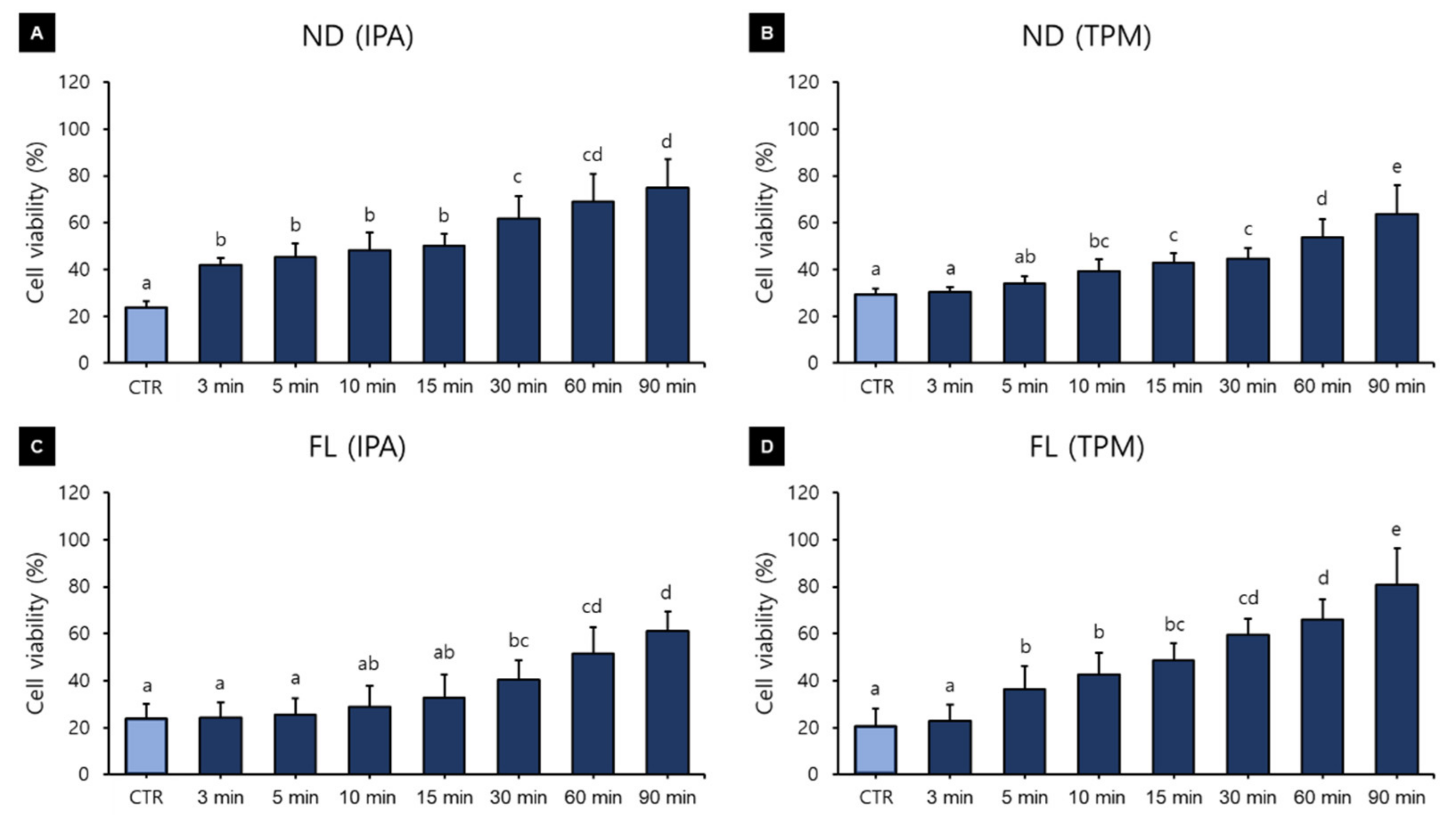

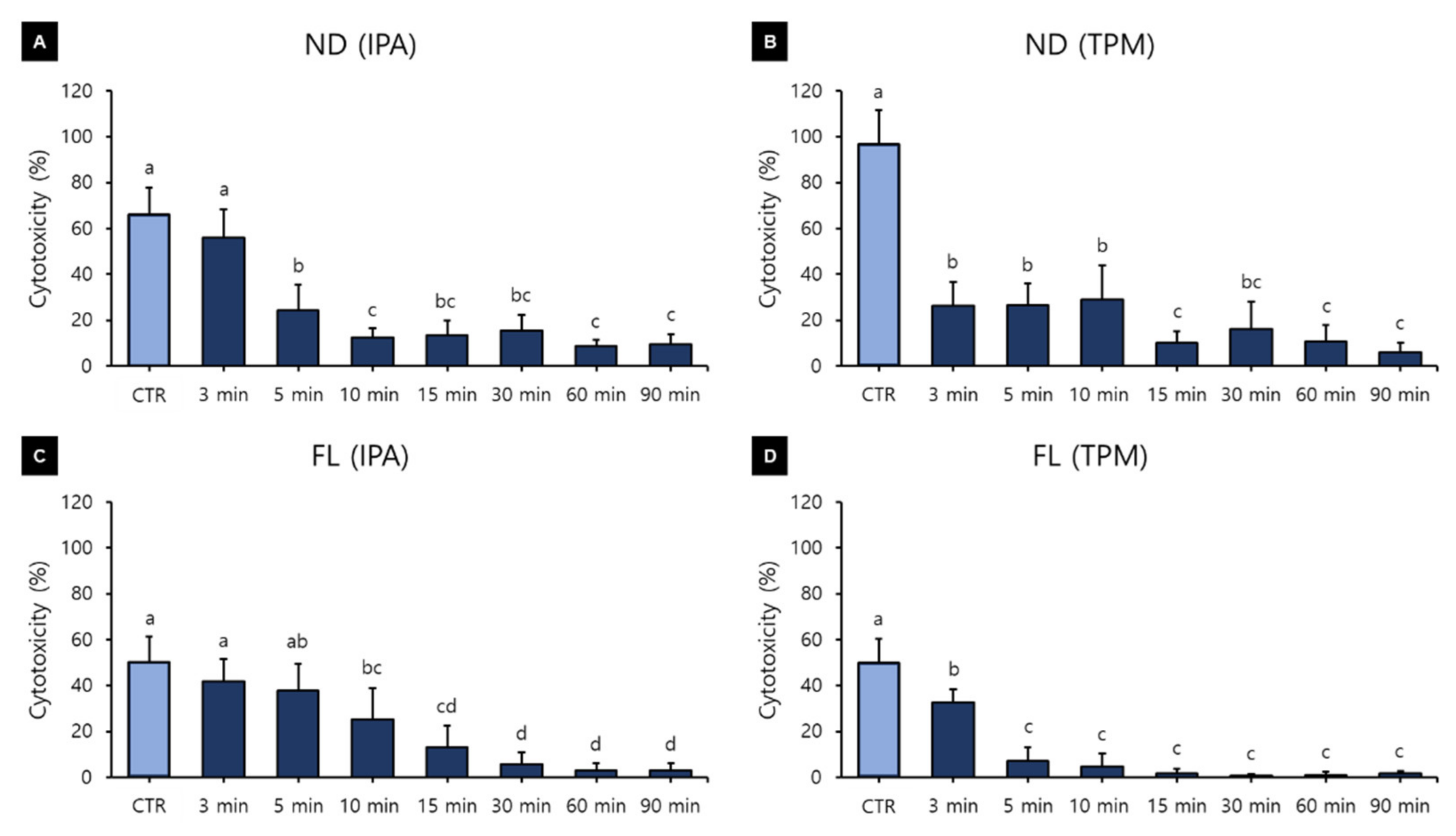
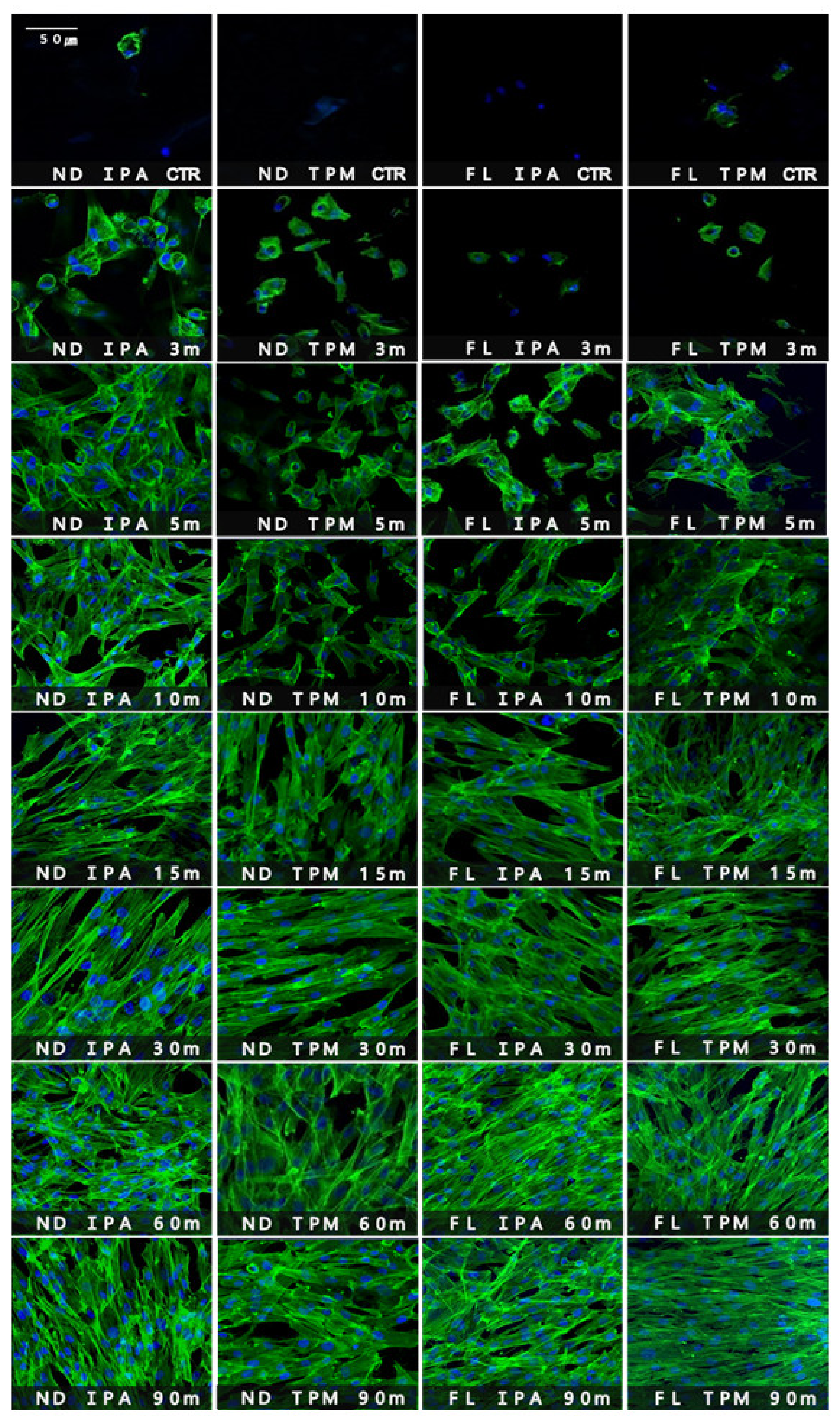


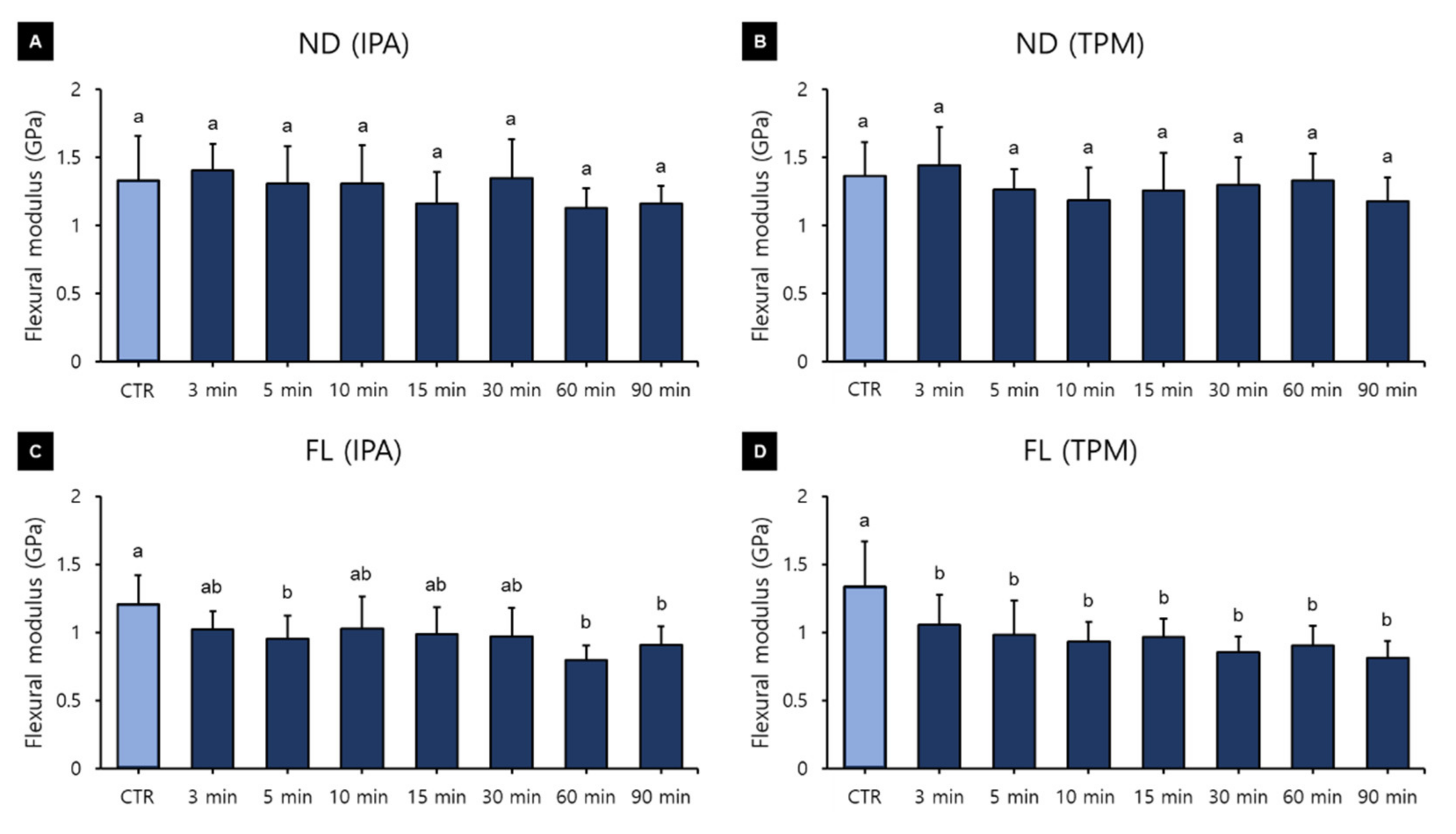
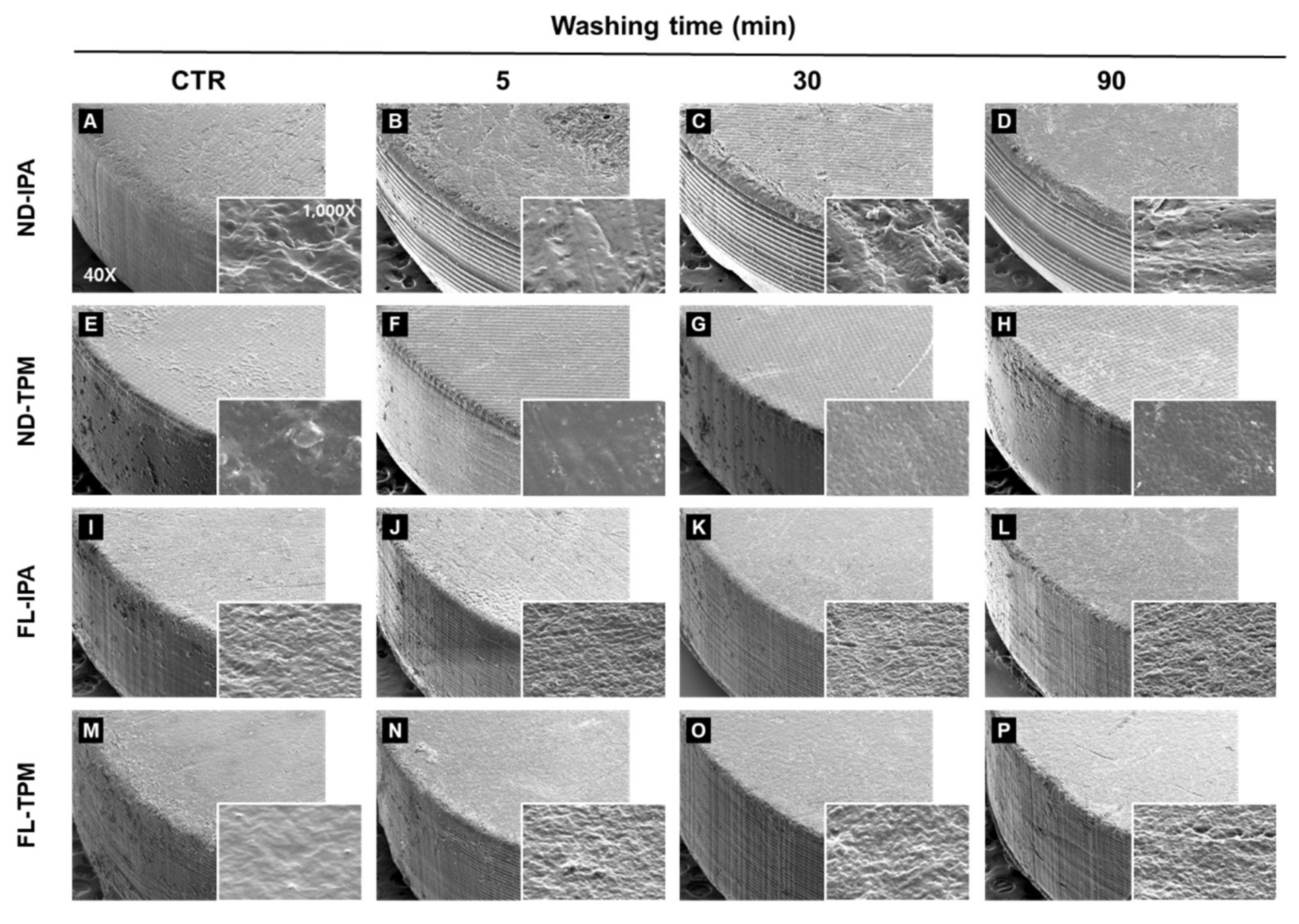
| Product | Code | Composition | Manufacturer |
|---|---|---|---|
| Formlabs Denture Teeth A2 | FLs | Methacrylate monomer, urethane dimethacrylate, propylidynetrimethyl trimethacrylate, diphenyl(2,4,6-trimethylbenzoyl) phosphine oxide | Formlabs, Somerville, MA, USA |
| NextDent C&B | ND | >90% methacrylic oligomers, methacrylate monomer, <3% phosphine oxides, pigment | NextDent, Soesterberg, the Netherlands |
| Product | Code | Purity | Evaporation Rate (n-Butyl Acetate = 1) | Flash Point (°C) | Vapor Pressure (mmHg) |
|---|---|---|---|---|---|
| Isopropyl alcohol | IPA | 90% | 0.0026 | 12 °C | 45.4 |
| Tripropylene glycol monomethyl ether | TPM | <95% | 2.3 | 111 °C | > 1 |
| Group | Cultivation Time (h) | Washing Time (min) | |||||||
|---|---|---|---|---|---|---|---|---|---|
| CTR | 3 | 5 | 10 | 15 | 30 | 60 | 90 | ||
| ND- IPA | 24 | 24.06 ± 3.48 | 42.82 ± 3.48 | 42.64 ± 3.36 | 43.37 ± 5.78 | 49.20 ± 5.62 | 57.23 ± 5.58 | 66.92 ± 10.98 | 77.23 ± 16.40 |
| 48 | 23.94 ± 1.01 | 43.62 ± 1.28 | 46.47 ± 4.84 | 53.00 ± 6.97 | 52.37 ± 5.00 | 66.61 ± 13.69 | 75.21 ± 13.34 | 81.00 ± 5.40 | |
| 72 | 23.08 ± 3.63 | 39.53 ± 1.73 | 46.39 ± 9.02 | 48.75 ± 7.22 | 49.47 ± 4.29 | 61.77 ± 5.78 | 65.31 ± 10.85 | 66.04 ± 9.02 | |
| ND- TPM | 24 | 28.05 ± 1.68 | 28.59 ± 1.45 | 32.21 ± 2.56 | 35.96 ± 0.67 | 39.51 ± 0.41 | 43.02 ± 4.48 | 54.25 ± 6.87 | 64.14 ± 13.35 |
| 48 | 31.85 ± 1.19 | 32.84 ± 1.20 | 35.82 ± 2.34 | 42.14 ± 6.84 | 47.19 ± 2.76 | 47.50 ± 5.31 | 57.24 ± 10.79 | 68.16 ± 15.43 | |
| 72 | 28.52 ± 1.22 | 29.71 ± 0.88 | 34.25 ± 2.85 | 39.89 ± 3.35 | 42.20 ± 2.15 | 43.26 ± 3.24 | 49.85 ± 1.20 | 59.15 ± 6.13 | |
| FL- IPA | 24 | 24.60 ± 0.50 | 25.52 ± 1.75 | 28.28 ± 2.11 | 32.84 ± 4.25 | 38.39 ± 4.77 | 43.16 ± 5.05 | 57.82 ± 7.35 | 59.53 ± 4.40 |
| 48 | 30.91 ± 0.52 | 31.07 ± 0.27 | 31.96 ± 0.81 | 36.20 ± 3.32 | 40.11 ± 2.49 | 45.69 ± 3.74 | 54.78 ± 7.92 | 57.43 ± 5.39 | |
| 72 | 15.70 ± 0.37 | 15.78 ± 0.29 | 16.09 ± 0.20 | 17.78 ± 1.36 | 19.73 ± 1.17 | 32.23 ± 7.82 | 41.83 ± 12.54 | 66.49 ± 11.49 | |
| FL- TPM | 24 | 28.04 ± 1.01 | 29.37 ± 2.35 | 38.27 ± 7.48 | 44.00 ± 13.40 | 47.00 ± 11.80 | 58.78 ± 7.90 | 66.32 ± 9.64 | 71.98 ± 13.73 |
| 48 | 22.94 ± 0.31 | 24.96 ± 0.89 | 39.44 ± 10.46 | 45.57 ± 5.34 | 50.13 ± 4.26 | 58.77 ± 8.08 | 63.68 ± 10.94 | 94.64 ± 16.43 | |
| 72 | 10.96 ± 0.16 | 13.99 ± 3.61 | 31.80 ± 11.28 | 38.75 ± 6.60 | 48.67 ± 5.02 | 60.59 ± 6.44 | 68.31 ± 4.35 | 75.78 ± 2.65 | |
| Group | Cultivation Time (h) | Washing Time (min) | |||||||
|---|---|---|---|---|---|---|---|---|---|
| CTR | 3 | 5 | 10 | 15 | 30 | 60 | 90 | ||
| ND- IPA | 24 | 57.38 ± 1.61 | 43.59 ± 4.07 | 16.79 ± 2.81 | 10.40 ± 1.18 | 10.20 ± 1.07 | 11.94 ± 1.86 | 10.44 ± 1.11 | 9.77 ± 1.49 |
| 48 | 62.97 ± 12.83 | 54.01 ± 6.29 | 18.48 ± 6.59 | 9.59 ± 1.34 | 9.69 ± 2.56 | 11.04 ± 3.48 | 5.97 ± 2.32 | 6.42 ± 3.38 | |
| 72 | 78.17 ± 4.53 | 70.33 ± 4.09 | 37.34 ± 8.32 | 17.42 ± 3.11 | 20.18 ± 7.18 | 23.21 ± 5.31 | 10.14 ± 1.87 | 11.85 ± 5.86 | |
| ND- TPM | 24 | 95.35 ± 18.17 | 14.52 ± 6.19 | 14.75 ± 2.63 | 14.29 ± 5.22 | 5.56 ± 2.44 | 6.05 ± 5.21 | 3.57 ± 3.08 | 2.23 ± 1.39 |
| 48 | 96.22 ± 15.73 | 30.93 ± 8.03 | 32.03 ± 2.63 | 33.11 ± 14.06 | 10.41 ± 4.74 | 17.06 ± 12.72 | 11.57 ± 3.81 | 5.88 ± 1.71 | |
| 72 | 98.18 ± 14.77 | 33.18 ± 5.57 | 33.49 ± 3.44 | 39.91 ± 9.66 | 14.11 ± 3.69 | 25.27 ± 7.46 | 16.74 ± 7.18 | 10.37 ± 1.86 | |
| FL- IPA | 24 | 40.70 ± 5.46 | 32.54 ± 1.49 | 27.03 ± 3.79 | 11.42 ± 1.51 | 4.76 ± 0.91 | 1.57 ± 0.74 | 0.06 ± 0.45 | 0.68 ± 0.39 |
| 48 | 45.73 ± 5.49 | 37.26 ± 1.30 | 33.27 ± 1.00 | 22.01 ± 1.63 | 9.28 ± 2.48 | 2.90 ± 1.35 | 1.93 ± 0.90 | 1.97 ± 0.97 | |
| 72 | 63.89 ± 2.86 | 55.04 ± 1.15 | 53.28 ± 2.01 | 42.48 ± 2.38 | 25.30 ± 4.19 | 12.26 ± 2.78 | 6.73 ± 2.70 | 6.42 ± 2.53 | |
| FL- TPM | 24 | 40.18 ± 2.21 | 27.34 ± 1.90 | 3.52 ± 3.43 | 1.62 ± 1.38 | 0.17 ± 1.94 | 0.49 ± 0.84 | 0.59 ± 1.03 | 1.09 ± 0.62 |
| 48 | 46.63 ± 1.83 | 30.46 ± 0.62 | 4.95 ± 2.69 | 3.14 ± 2.56 | 1.69 ± 1.52 | 1.40 ± 0.22 | 2.06 ± 1.04 | 2.41 ± 0.69 | |
| 72 | 62.98 ± 3.45 | 39.98 ± 2.79 | 13.06 ± 5.75 | 9.34 ± 7.65 | 2.92 ± 2.12 | 0.18 ± 0.50 | 0.62 ± 0.71 | 1.38 ± 1.12 | |
Publisher’s Note: MDPI stays neutral with regard to jurisdictional claims in published maps and institutional affiliations. |
© 2021 by the authors. Licensee MDPI, Basel, Switzerland. This article is an open access article distributed under the terms and conditions of the Creative Commons Attribution (CC BY) license (https://creativecommons.org/licenses/by/4.0/).
Share and Cite
Hwangbo, N.-K.; Nam, N.-E.; Choi, J.-H.; Kim, J.-E. Effects of the Washing Time and Washing Solution on the Biocompatibility and Mechanical Properties of 3D Printed Dental Resin Materials. Polymers 2021, 13, 4410. https://doi.org/10.3390/polym13244410
Hwangbo N-K, Nam N-E, Choi J-H, Kim J-E. Effects of the Washing Time and Washing Solution on the Biocompatibility and Mechanical Properties of 3D Printed Dental Resin Materials. Polymers. 2021; 13(24):4410. https://doi.org/10.3390/polym13244410
Chicago/Turabian StyleHwangbo, Na-Kyung, Na-Eun Nam, Jong-Hoon Choi, and Jong-Eun Kim. 2021. "Effects of the Washing Time and Washing Solution on the Biocompatibility and Mechanical Properties of 3D Printed Dental Resin Materials" Polymers 13, no. 24: 4410. https://doi.org/10.3390/polym13244410
APA StyleHwangbo, N.-K., Nam, N.-E., Choi, J.-H., & Kim, J.-E. (2021). Effects of the Washing Time and Washing Solution on the Biocompatibility and Mechanical Properties of 3D Printed Dental Resin Materials. Polymers, 13(24), 4410. https://doi.org/10.3390/polym13244410






